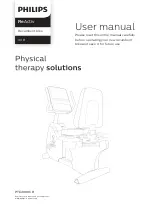
Glossary
19
Bio Feedback
Acoustic and/or optical feedback on the metabolism and condition of the body.
Coaching
Automatic training control oriented towards training objectives.
Energy balance
The balance between energy intake and energy usage. There can only be a balance if intake and
output are the same. For example, in Germany every person consumes on average 400 - 500 Kcal more than he or she
can use.
Joule (J)
; kiloJoule (kJ) = 1000 Joule; MegaJoule (MJ) = 1000000 Joule
Energy measurement unit, named after the british physicist James Prescott Joule. (see calorie)
Calorie (cal)
Energy measurement unit. Officially obsolete, but still in common use. It refers to thermal energy in
particular. The conversion factor to the unit in use today (J): 1 cal = 4.1868 J, or the other way around 1 J = 0.2388 cal.
LED
Light Emitting Diode: when current is passed through a LED it emits light, either visible or invisible. It is used for
indicator lamps or remote controls.
Aching muscles
Painful phenomenon of the muscles tissues, occurring when the aerobic zone is exceeded leading
to an overproduction of lactic acid. In order to avoid it, the device compares measured data, input parameters and
statistical values and displays the resulting aerobic zone status.
Physiology
The science of life processes.
BMI
Body Mass Index
RPM
R
P
M
evolutions er
inute.
Self test
When switched on, the ergo_bike computer checks the electronic circuits it uses to make sure every thing f
unctions properly.
Aerobic zone
The training phase during which the load on the muscles is enough to keep them supplied with oxygen,
but not enough to cause an overproduction of lactic acid (aching muscles). Aerobics also makes use of the aerobic zone.
Virtual Reality
An illusion of reality generated by technical means that is influenced by external impulses or gives
impulses to its surrounding. The device uses these possibilities through an optional accessory set.
Watt (W)
Unit of measure of the work done per unit time:
1 W = 1 J / s = 1 Nm / s = 1 VA
WHO
World Health Organization
Eddy current brake
Uses the fact that electric currents induced in a conductor by a fluctuating magnetic field produce
joule-type energy which can be used for an electronically controlled brake.
Physical kJoule (phys-kJ) / Physical MegaJoule (phys-MJ)
This value does not cover the energy needed by the body to maintain its vital functions
(e.g. respiration, blood circulation, metabolism).
Represents only the mechanical work done on the ergometer; it is computed by mean of the following formula:
Power [Watt] * Time [Sec] = Work [Joule]
Exemple100 Watt * 60s = 6000 Joule = 6 kJoule
Realistic kJoule (real-kJ) / Realistic MegaJoule (real-MJ)
Using the data of the height, the weight, the age, and the sex, the system computes the approximate basic and total
quantity of burned energy. The system will then display the approximate amount of kJoule actually burned during the
training on the ergometer.
Distance covered in kilometres (km)
Distance
Time
Training time in minutes (for present training data) / in hours (for total training data)
Summary of Contents for Fitness 3
Page 1: ...3 3 3 User manual ...
Page 37: ......













































